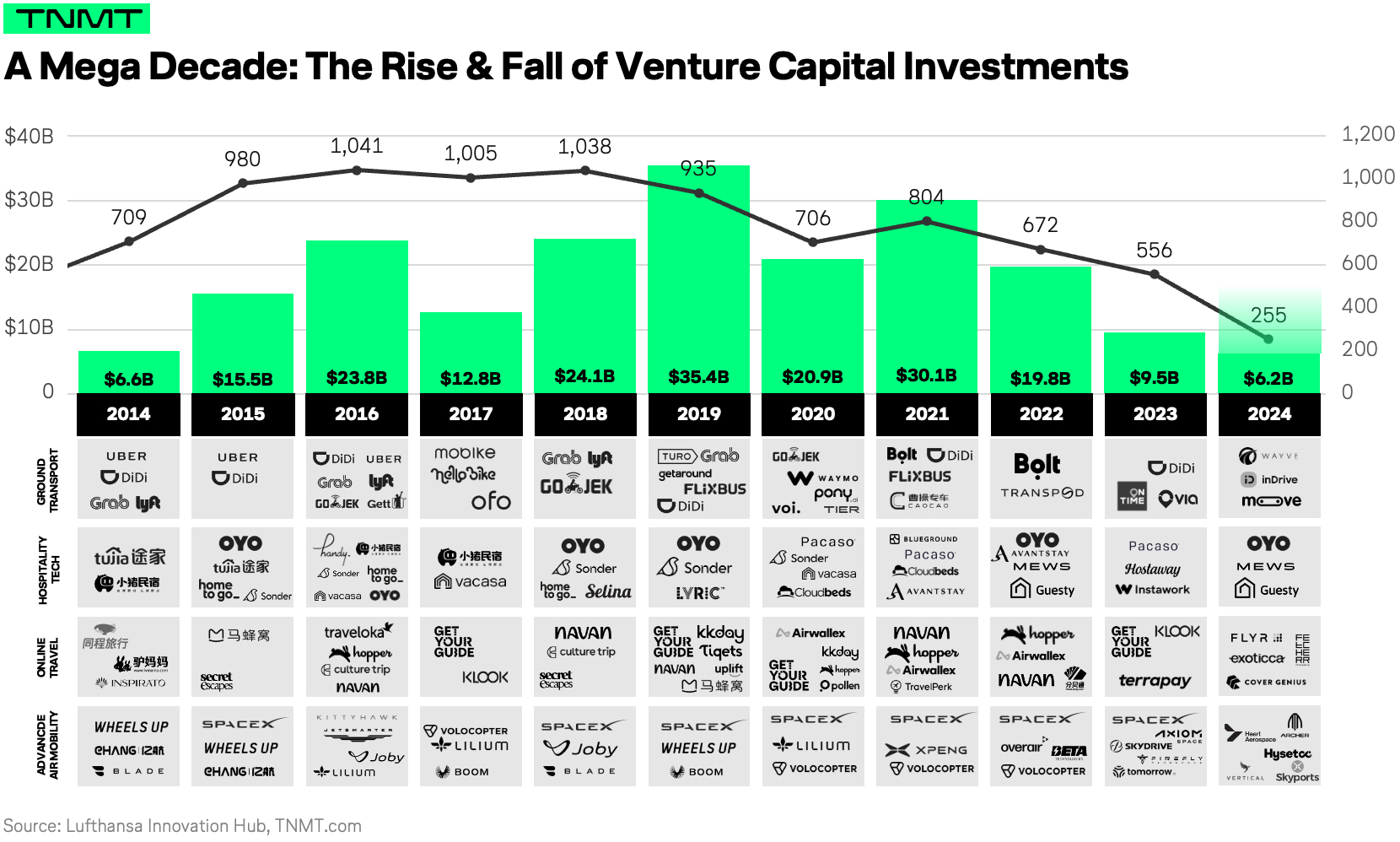Today’s research deep dive is built around a data point we didn’t really see coming:
Airport satisfaction is quietly hitting record highs.
- According to a 2025 report by Airport Dimensions, 79% of global travelers now report being satisfied with their airport experience.
- This is up sharply from just 60% in 2019, before the pandemic disrupted global travel, and marks the highest level recorded in the past decade.
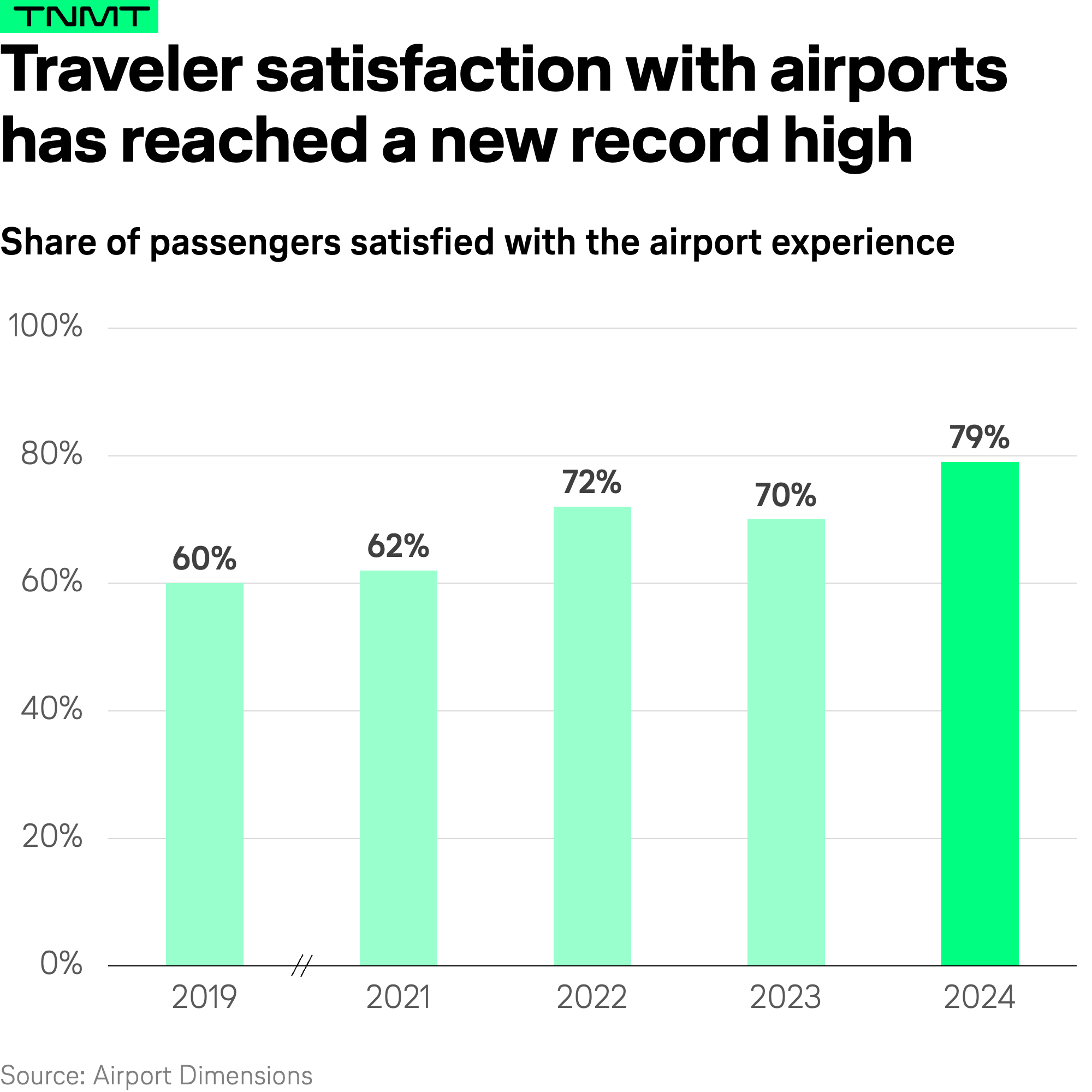
This trend took us by surprise. At least a little bit.
Not because we didn’t think airports could ever change, but because the shift is happening faster and more visibly than we expected.
Back in 2019, we published a rather bearish take on airport innovation.
At the time, we identified four structural blockers that kept startups (and real innovation) out of airport environments:
- A highly consolidated airport oligopoly with little competitive pressure.
- Complex, slow-moving procurement processes.
- Risk-averse operators favoring big tech incumbents.
- And regulatory red tape that made experimentation nearly impossible.
Airports, unlike airlines, had barely begun exploring meaningful digital innovation. The ecosystem was closed, sluggish, and disincentivized to try (almost) anything new.
We ended that piece with cautious optimism: if startups could find the right entry points, like profit-sharing, critical-mass incubation programs, or positioning the airport as just one of many distribution channels, things might eventually change.
Fast forward to today, and change is clearly underway (see chart above).
So we decided to investigate:
- What’s behind this post-pandemic turnaround in passenger satisfaction?
- Where have airports focused their innovation efforts?
- And most importantly: what can the rest of the industry, especially airline innovation managers, learn from all this?
What we found: this isn’t just about isolated upgrades.
It’s a mindset shift. And one that’s starting to show real commercial returns.
Let us explain.
Single airport innovations add up
The rise in passenger satisfaction isn’t a coincidence.
It reflects a clear uptick in innovation momentum inside airport environments. Around the world, we’re seeing more and more experiments being rolled out–not in test labs, but in real terminals, for real travelers.
And this trend is increasingly showing up in media headlines.
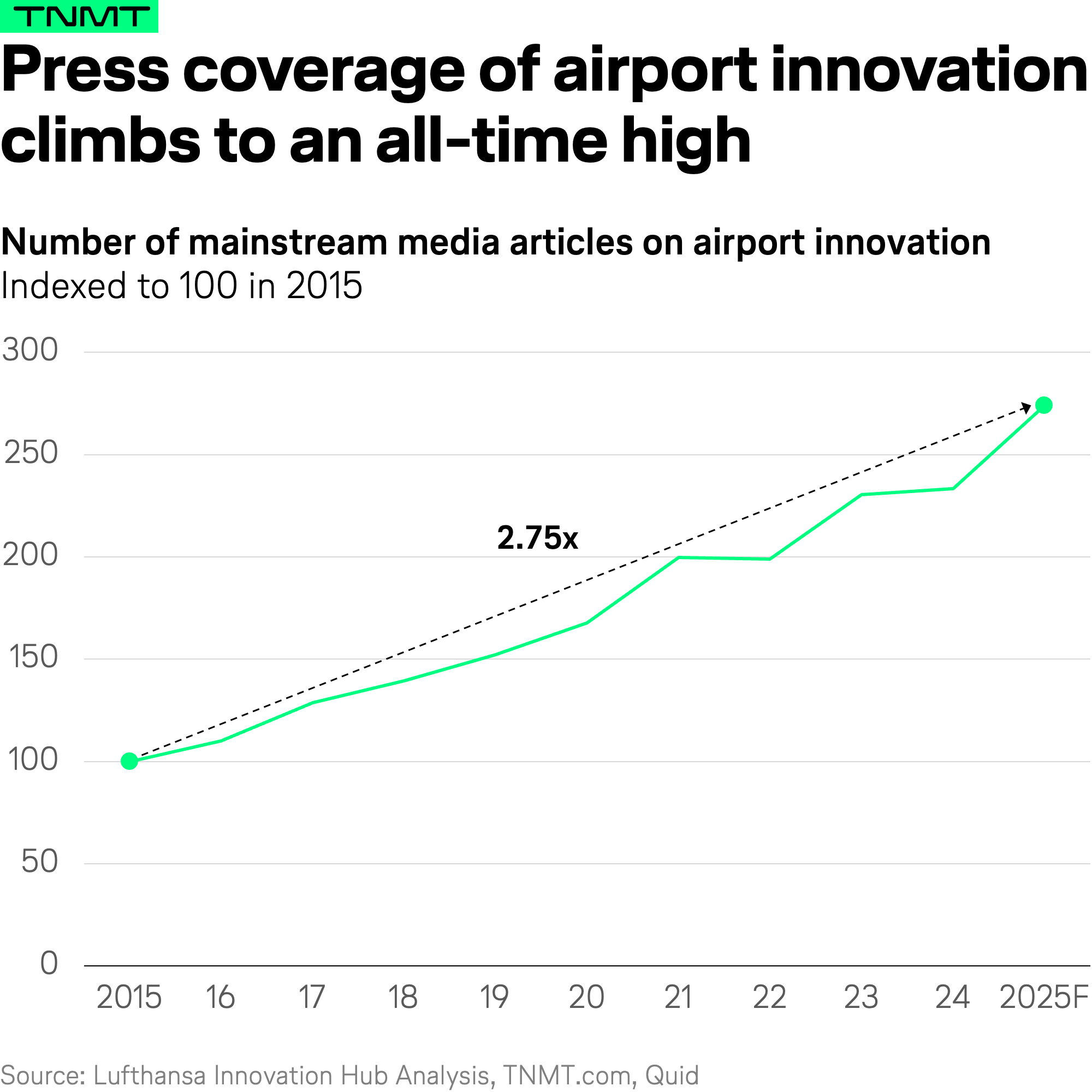
Here are a few headline examples:
- No passport required at immigration. At Changi Airport, travelers can now clear immigration without ever pulling out their passport, thanks to fully automated biometric ID checks. The process is faster, smoother, and less stressful.
- No more “where the hell is my gate?” chaos. At Bogotá’s El Dorado Airport, a robot named DoraBot gives real-time gate updates, directions, and flight info in multiple languages.
- Just walk out shopping. In Hong Kong Airport, some duty-free stores now let travelers skip checkout entirely. Scan your boarding pass, grab what you need, and walk out. The receipt lands in your email inbox.
- Your bags aren’t the only thing getting help at the belt. In Munich, autonomous Ottonomy robots now assist travelers at baggage claim, offering directions and guiding them to their next stop.
Even though these are all still isolated examples, limited to a few airports and serving a fraction of passengers, they’re solving real traveler micro-frictions.
And collectively, that’s starting to shift how people feel about the entire airport experience.
So what’s sparked this new momentum?
Covid cracked the system open
In hindsight we can tell: the pandemic turned out to be a forcing function.
Practically overnight, airports had to rethink their operations.
What used to be long-term “digital transformation” roadmaps suddenly became urgent priorities.
- Touchless check-in via mobile apps or kiosks, minimizing human interaction.
- Digital queue management, like notifications and virtual queue monitoring, to help travelers avoid crowded lines.
- Biometric screening and facial recognition to replace face-to-face passport and boarding pass checks.
- Contactless payments, including tap-to-pay for parking and food courts
- Self-service bag drops reduce face-to-face contact while speeding up check-in.
- Automated cleaning robots are a visible hygiene upgrade that also boosts traveler confidence.
All of it moved from nice-to-have to must-have (within weeks).
Airport boards, traditionally risk-averse and slow to change, found themselves with no real choice. Crisis forced airports to do what we (and many analysts) had long advised: modernize.
And this shift didn’t go unnoticed.
- Startups, many of which had long been locked out of the airport environment, spotted the opportunity.
- Just as we predicted back in 2019, they began re-entering the picture with business models better aligned to airport realities.
Some leaned into profit-sharing models to get their foot in the door.
Others piggybacked on broader digitization waves, like biometric identity or autonomous robots.
The result?
A real mindset shift – one that quickly turned into structural change in how airports think about and fund innovation.
To support this argument, we’ve identified three clear signals that this shift is here to stay.
Signal #1: Innovation is now someone’s actual job
The strongest indicator that airport innovation is here to stay?
Airports have started building dedicated innovation teams, with clear budgets, mandates, and leadership backing.
And this shift is bigger than just one or two standout examples. We’ve identified 30+ formal airport innovation units across the globe.
What’s striking: Close to 90% of them were founded in the past five years, pointing to a post-pandemic pivot where innovation became less of a buzzword and more of an organizational priority.
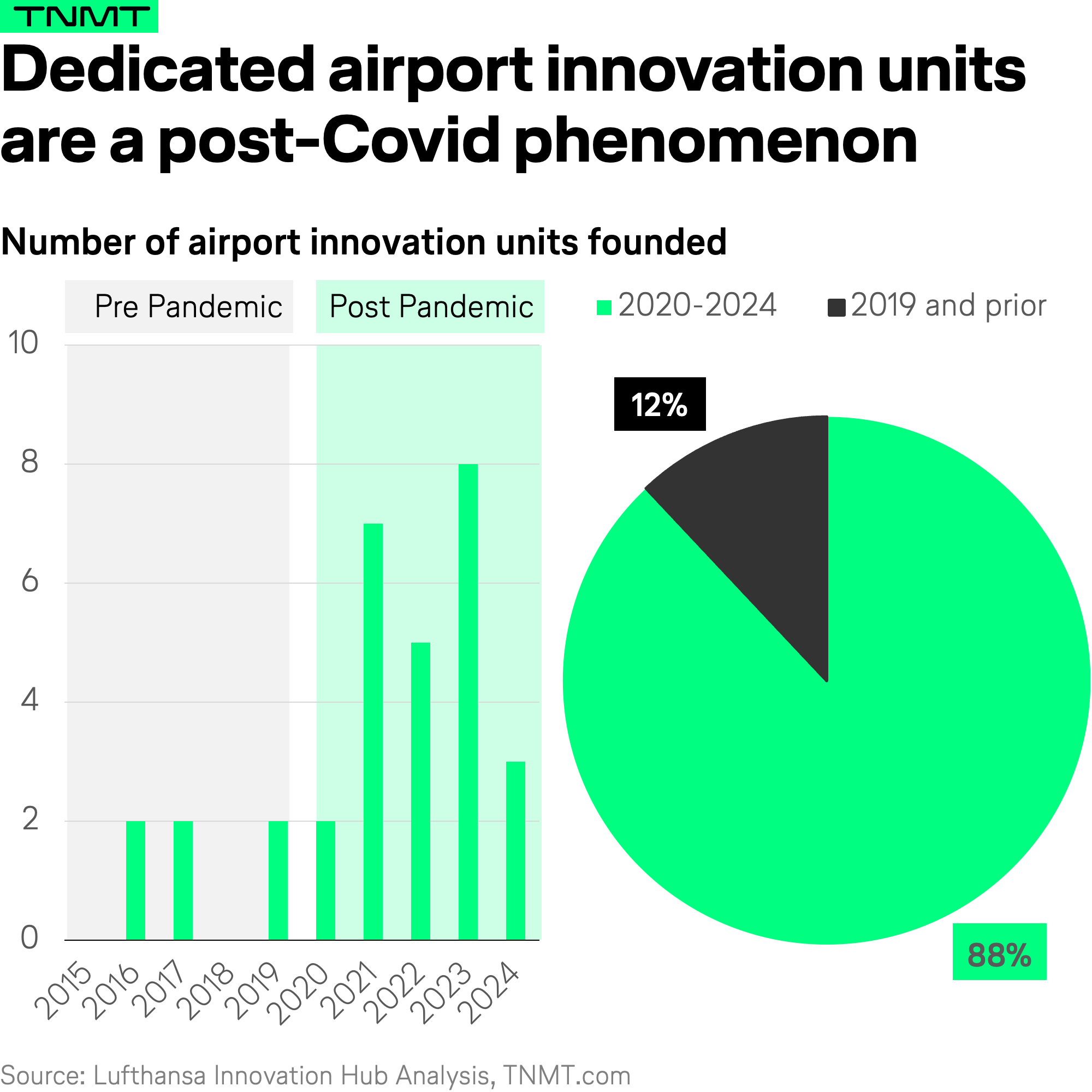
These units range from corporate venture arms and startup accelerators to full-blown innovation labs embedded within the airport operator itself. Think ADR’s Innovation Hub in Rome, Munich Airport’s Lab Campus, Zurich’s Innovation Hub, or Aena’s startup accelerator Aena.
As we uncovered in our recent scan of 100+ innovation units across the aviation sector, most airport teams today concentrate their efforts on two main fronts:
- Automation and robotics to improve operational efficiency.
- Data analytics to optimize passenger flows and airport capacity planning.
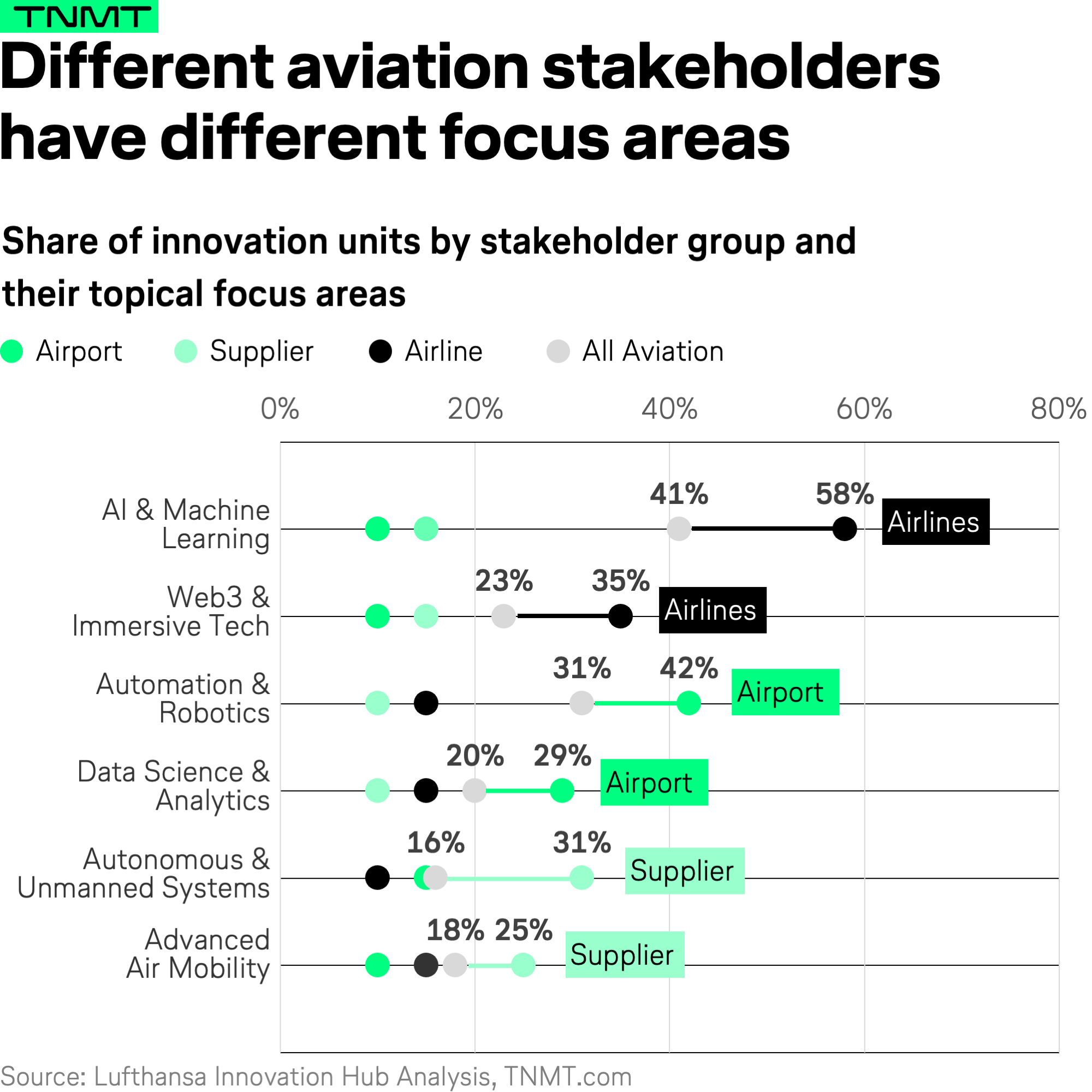
Bottom line: Innovation is no longer just a side project driven by a few enthusiastic employees. It’s become structured, funded, and deeply intentional.
Signal #2: Airports are outspending airlines on tech
Another clear sign that airport innovation is no longer just talk?
They’re putting their money where their mouth is.
Since the pandemic, airports have significantly ramped up their tech budgets, quietly outpacing even their airline peers.
- Back in 2019, airports spent less than 5% of their revenue on technology.
- Fast-forward to 2024, and that figure has risen to nearly 6%.
- By contrast, airline IT spending has actually gone the other way: dropping from roughly 5% of revenue in 2019 to under 4% today.
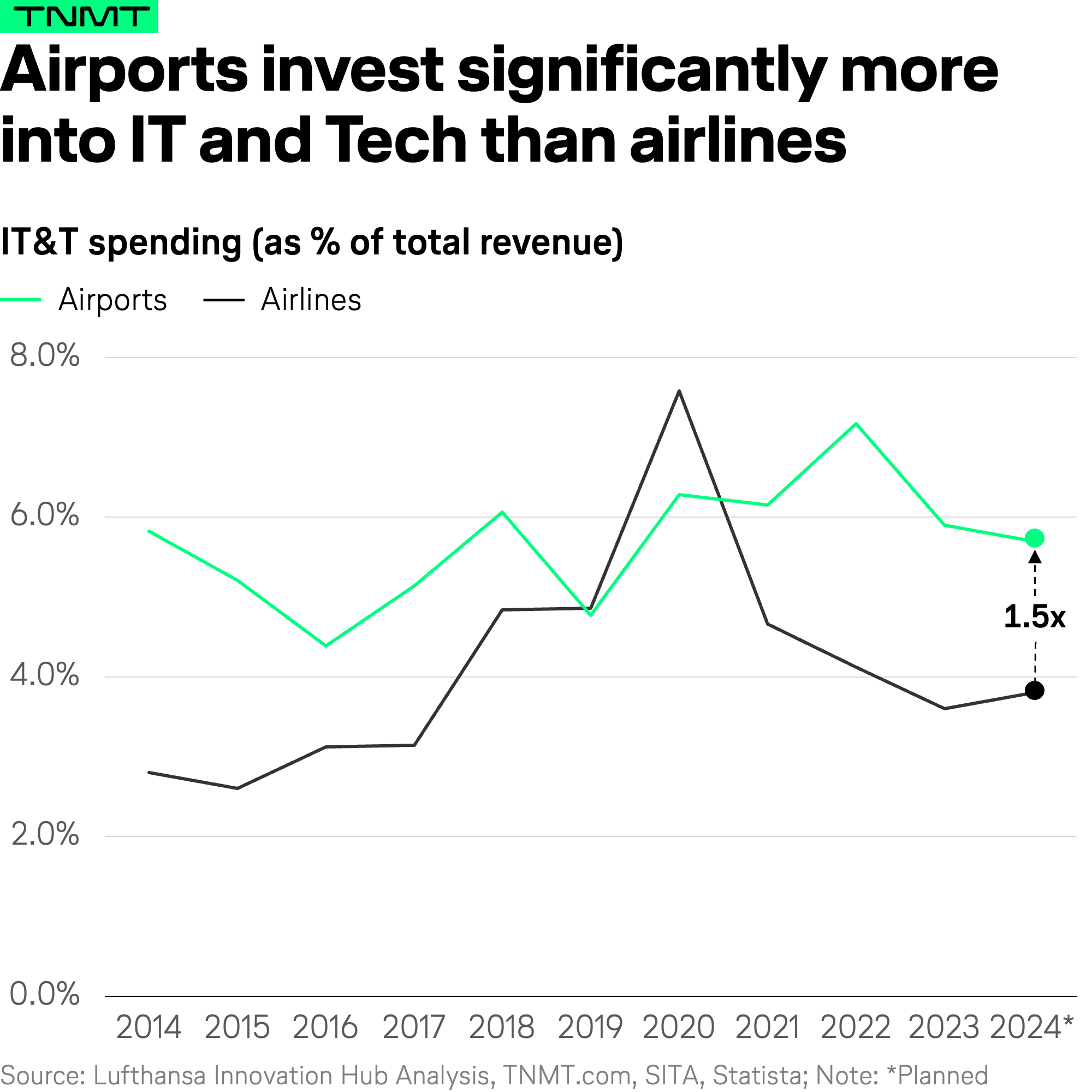
In other words, airports now spend 1.5x more on IT than airlines, which is a notable reversal of the historic dynamic where airlines led the charge on digitization efforts.
This budget shift may sound subtle, but it’s massive when you consider the total revenue volumes involved.
- Airports are no longer passively waiting for tech suppliers to lead the innovation agenda.
- They’re taking control of their own digital transformation, and funding it accordingly.
Signal #3: VC confidence in airport tech is holding strong
Our final signal doesn’t come from inside the terminal, but from the wider innovation ecosystem.
While overall startup funding in Travel and Mobility Tech has nosedived in recent years, investor appetite for airport-focused innovation has remained remarkably resilient.
- Since the 2018 peak, the number of VC deals across the broader Travel and Mobility Tech market has fallen by almost 50%.
- But deals targeting airport-specific startups? Mostly stable up until 2022, and then only down ~20% until 2024.
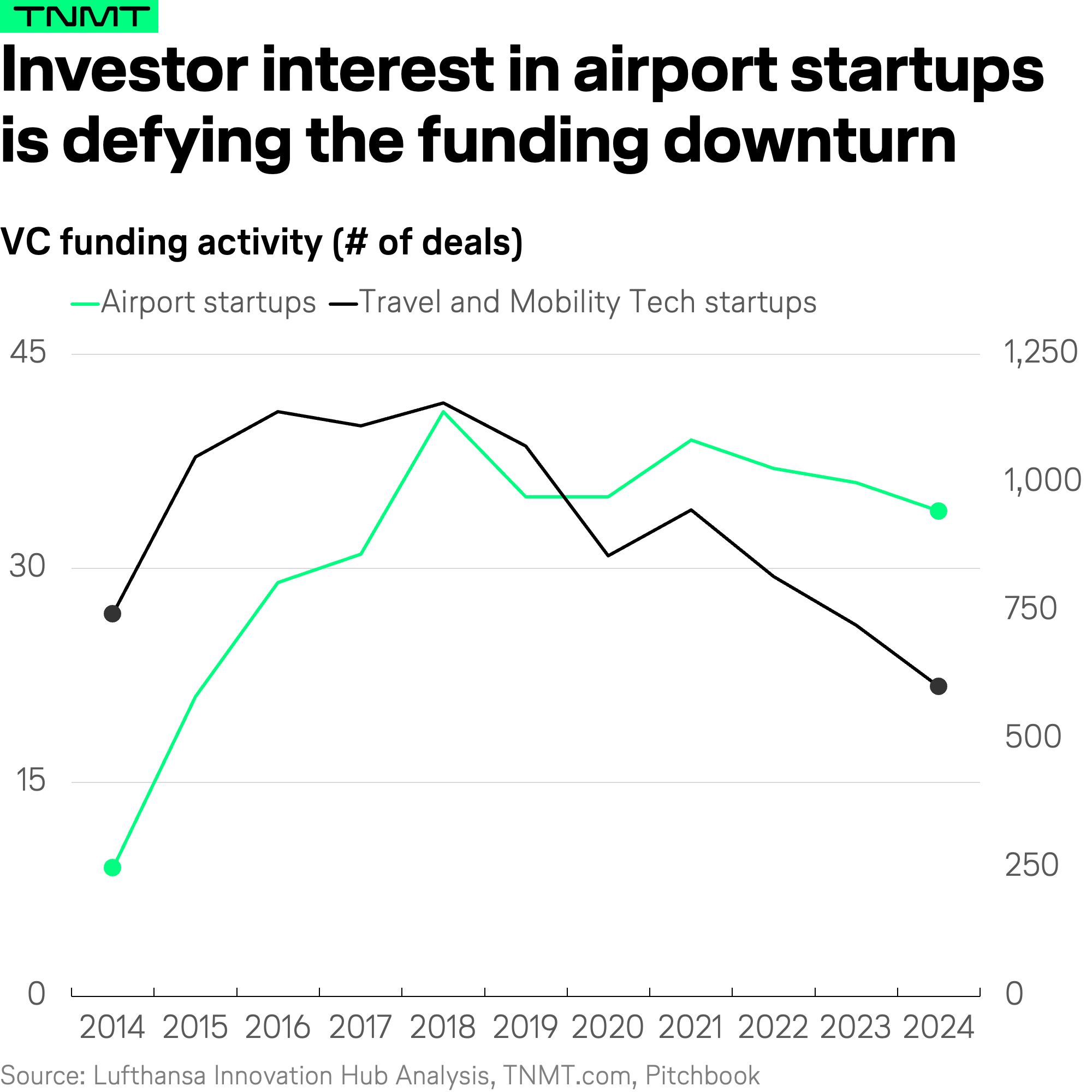
In the middle of a global VC winter, that’s a strong vote of confidence.
It shows that external investors have picked up on what we’ve been tracking internally:
Airports are finally enabling the conditions startups need to succeed.
- Longer runways for testing.
- Faster procurement cycles.
- More openness to startup partnerships.
And crucially: real budget behind the buzz (see Signal #2).
By the way, most of the VC funding has flowed into the same priority areas where airports are ramping up internal spending, namely automation, robotics, and AI.
Here are 9 startups that caught our eye recently:
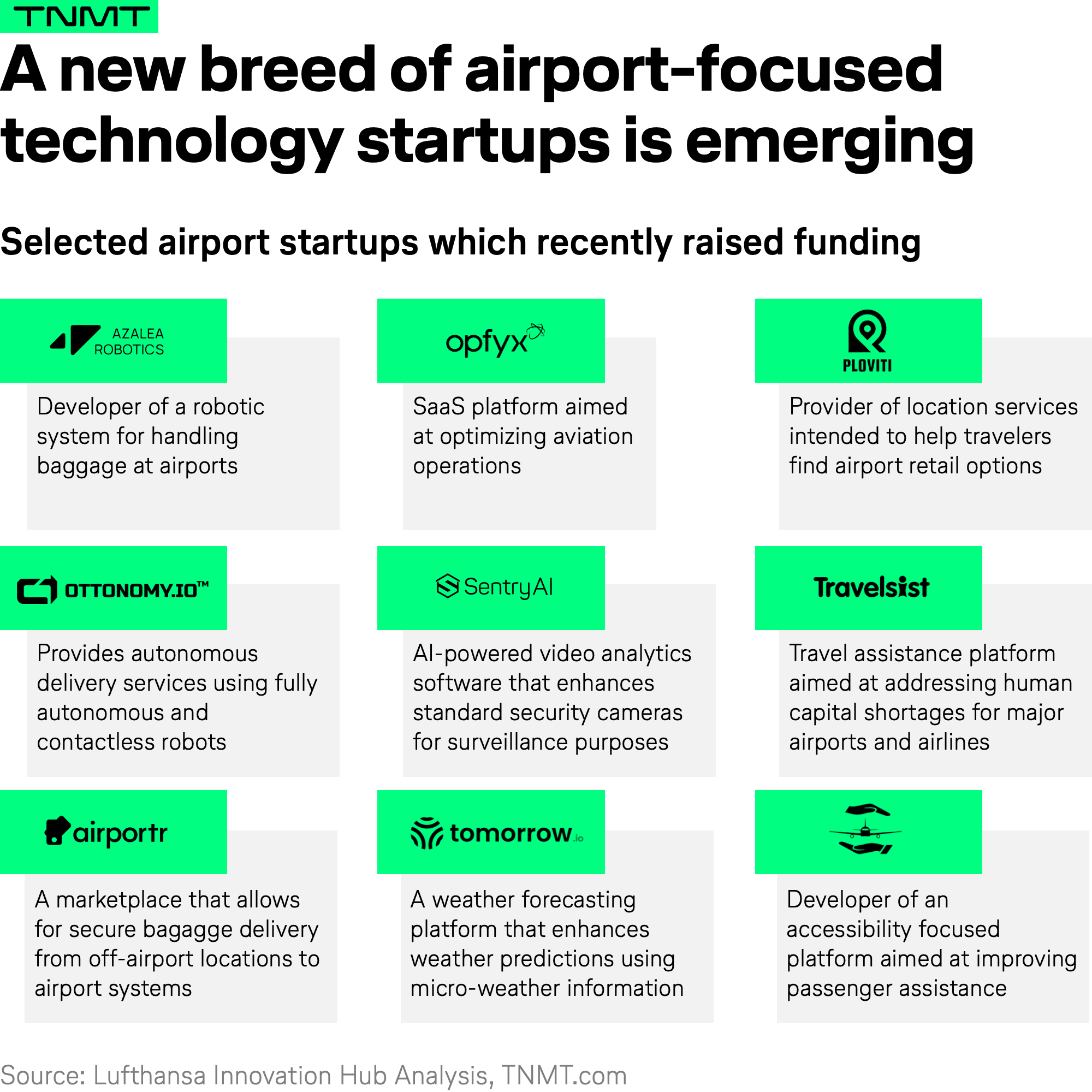
In short, the ecosystem around airports is catching up to the moment.
And it’s helping fuel a more innovation-ready future across the terminal.
Why airline collaboration is the next big airport innovation unlock
With all these promising airport innovation signs in front of us, we can only point in one direction:
Now is the time for airlines and airports to collaborate more closely than ever.
The current airport innovation momentum offers a rare window of opportunity. For once, airports aren’t just open to new ideas; they’re actively funding, testing, and scaling them.
But here’s the catch: A better passenger experience can’t be delivered in silos.
- Airlines and airports touch nearly every part of a traveler’s journey, yet they often operate in parallel, not in sync.
- That fragmentation is holding back the full potential of seamless, end-to-end experiences.
It’s also bad for business.
Because when passengers are frustrated, they spend less. But when they’re happy? They open their wallets.
- According to JD Power’s 2023 North American Airport Satisfaction study, delighted travelers spend nearly 50% more at airports than stressed-out or disappointed ones.
- This uplift affects everyone’s bottom line, from airport retailers to airlines offering seat upgrades, meals, or priority boarding at the gate.
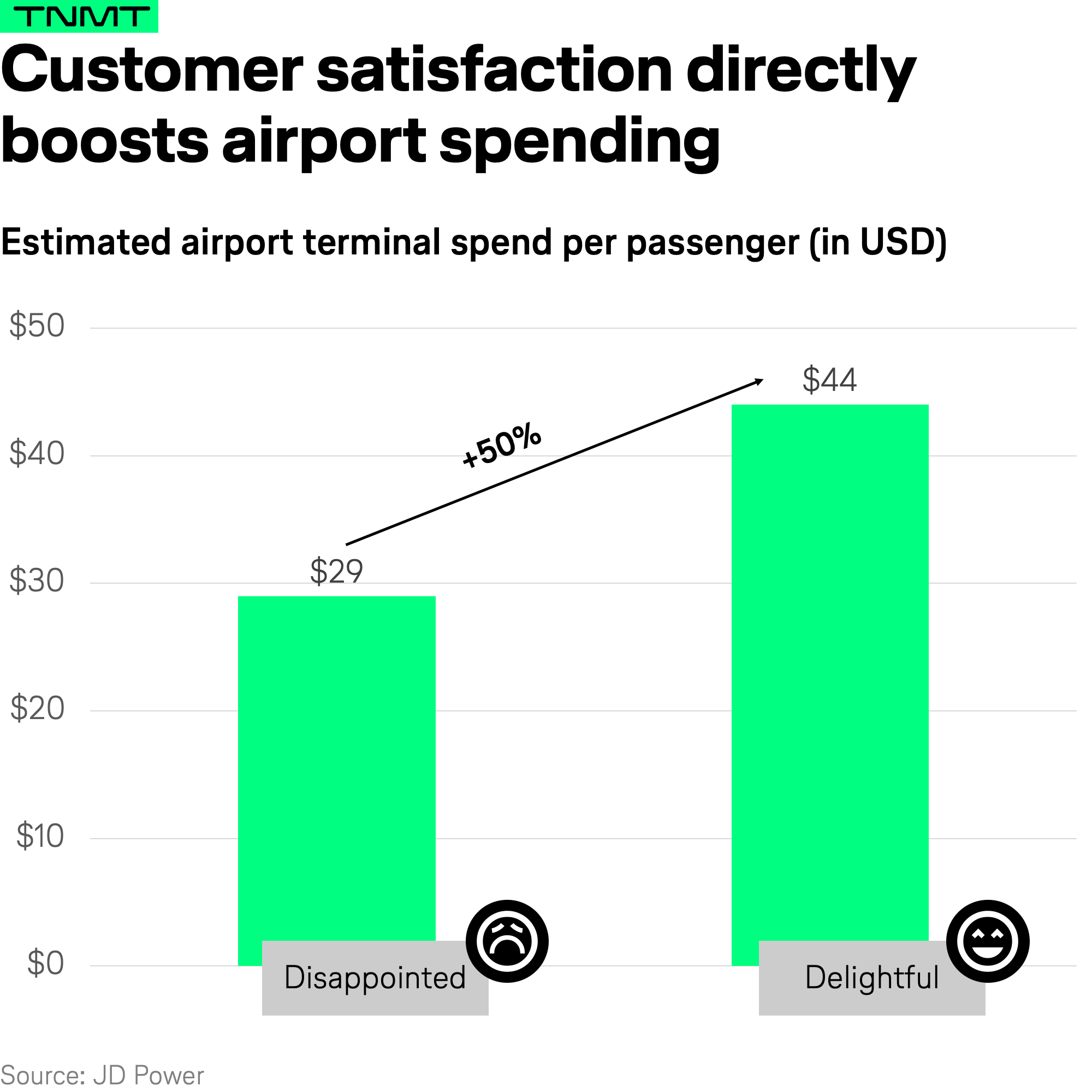
So what can airlines do to ride this wave, and actually lead in shaping what’s next?
They should start by aligning with airports’ top strategic tech priorities.
Here are the three focus areas where collaboration can make the biggest impact:
1. Biometrics are the runway to frictionless journeys
Airports are going all-in on biometric identity solutions. From facial recognition to digital IDs, these tools and technologies are streamlining immigration, security, and boarding.
According to Amadeus’ 2024 Technology Investment Trends report, nearly 50% of airports around the world are prioritizing the rollout of biometric-enabled processes in 2025, with a clear goal: an “ultra-light” passenger journey.
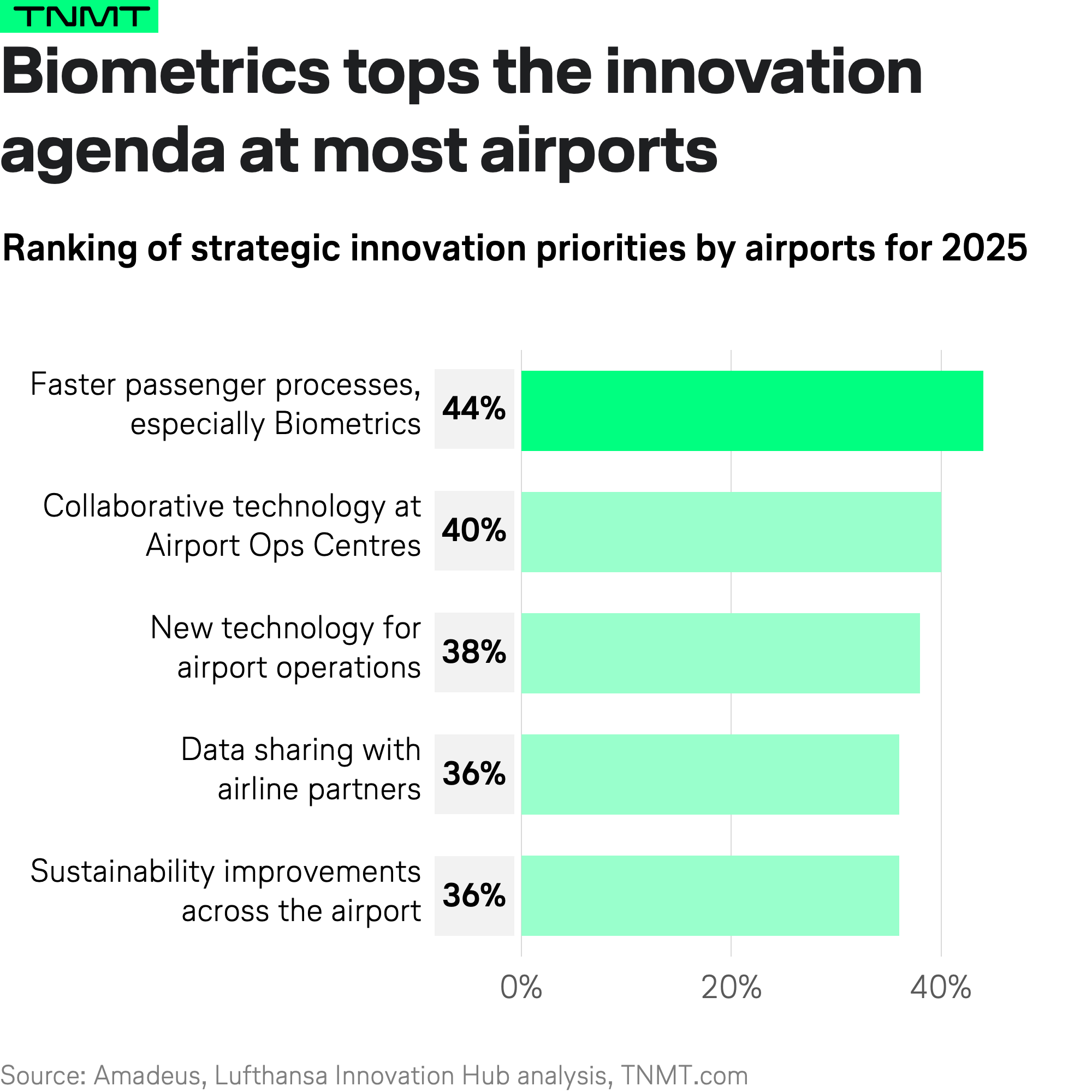
For airlines, this is a golden chance to integrate boarding processes, loyalty programs, and mobile apps with airport biometric systems.
2. Self-service expansion is accelerating
Check-in kiosks and bag-drop stations are old news.
What’s new is the speed at which self-service is now being scaled across every part of the airport journey. Airports plan to expand comprehensive self-service infrastructure, from curb to gate, by the end of 2025.
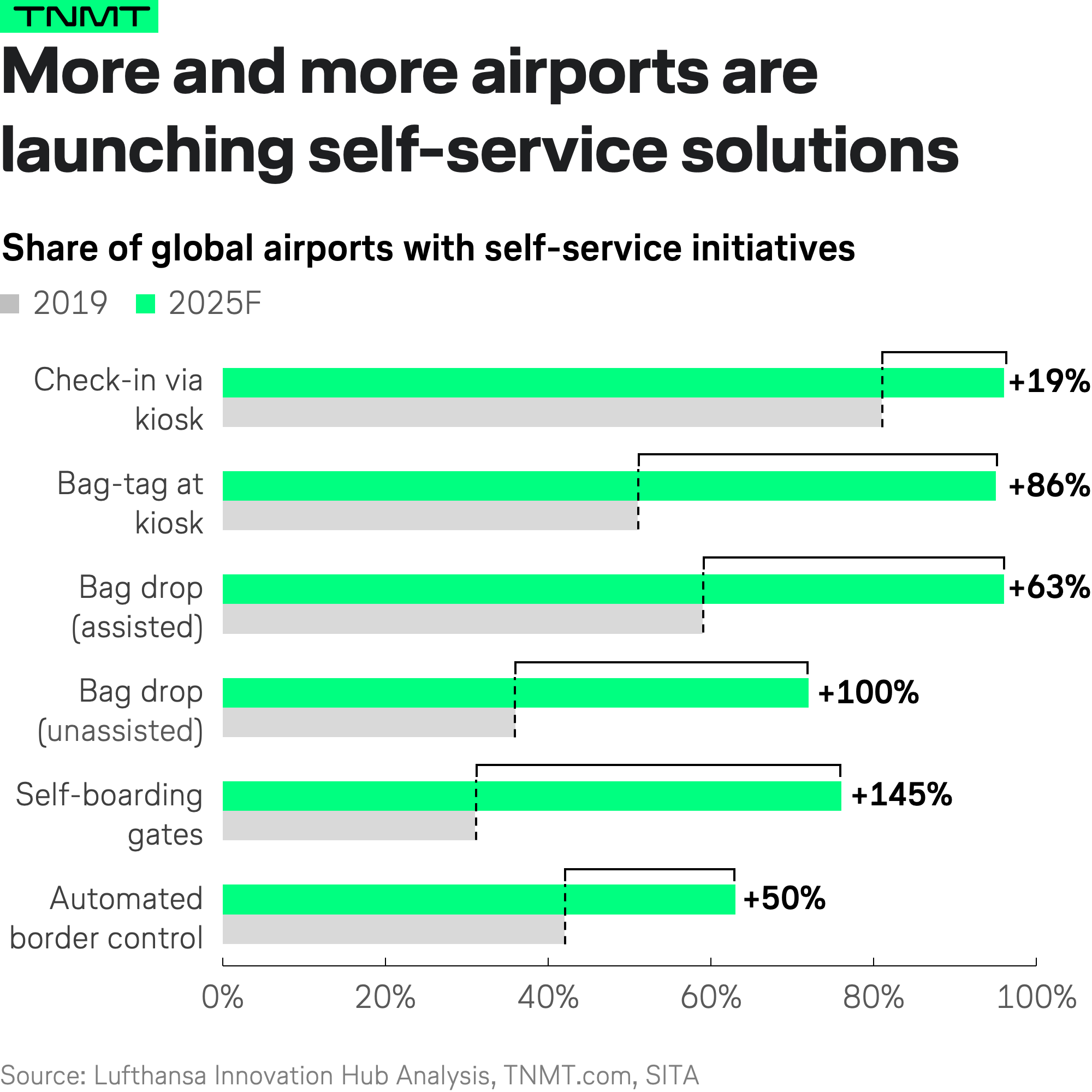
Airlines should view this not as a “loss of human touch” but as an opportunity to redirect resources to more high-impact moments (think gate agents who can assist with rebookings instead of merely scanning boarding passes).
3. Automation and robotics to combat labor gaps
Staffing shortages remain one of the biggest threats to airport stability.
That’s why automation is climbing to the top of the innovation agenda.
This includes cleaning bots and autonomous baggage handlers, technology that fills gaps that humans can no longer fulfill, at least not at scale.
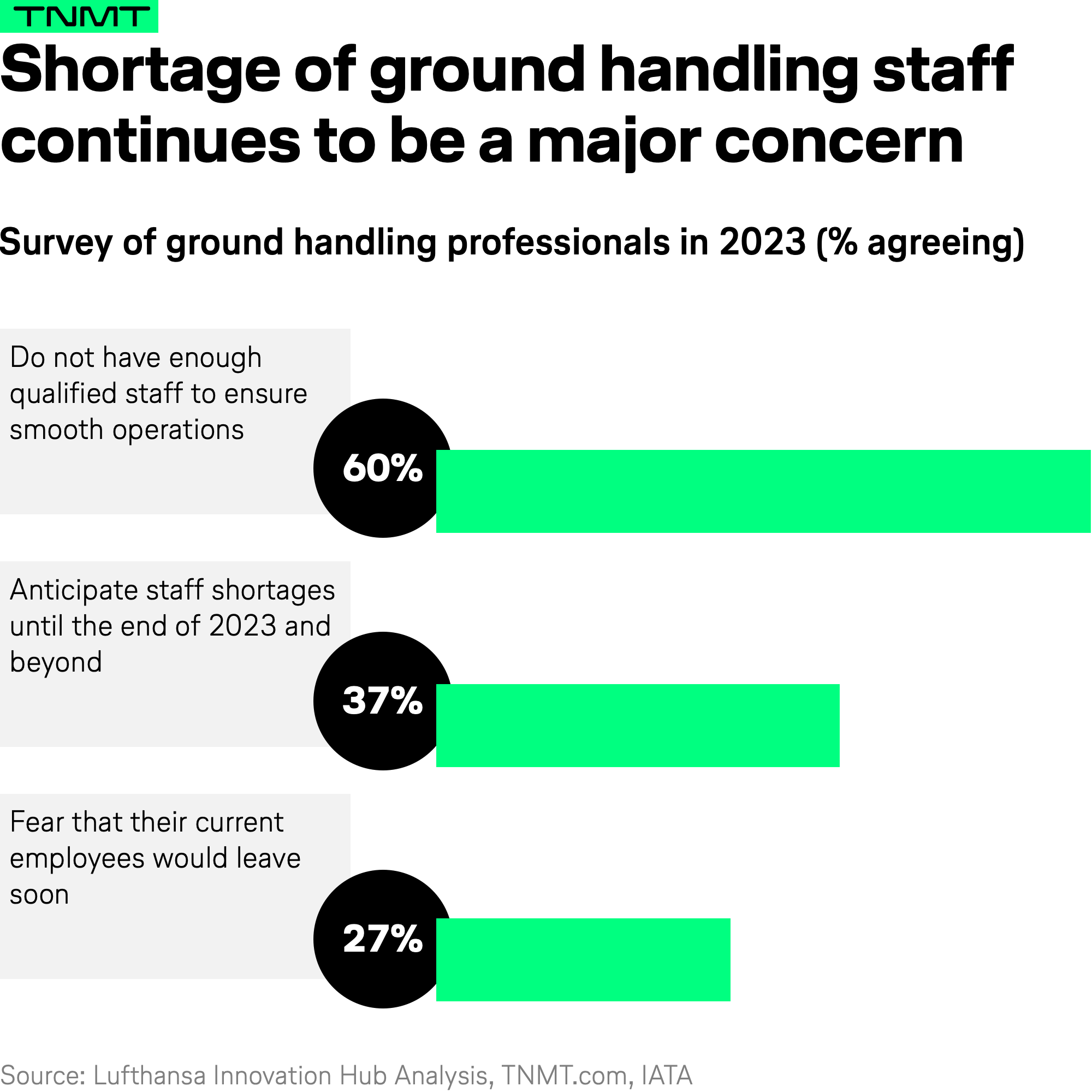
Partnerships with robotics startups are key here.
Recent examples include:
- SkyBot Lab at Castellón Airport (Spain), launched in May 2025, provides companies with a live testbed for mobile robotics, ranging from surveillance drones to logistics bots.
- Changi Airport Group is testing the Automated Prohibited Items Detection System (APIDS), an AI-powered scanner that flags threats in carry-on baggage faster and more accurately than human screeners. Early results? Clearance times cut by up to 50%.
Here is an overview of the major robotics use cases in the airport context:
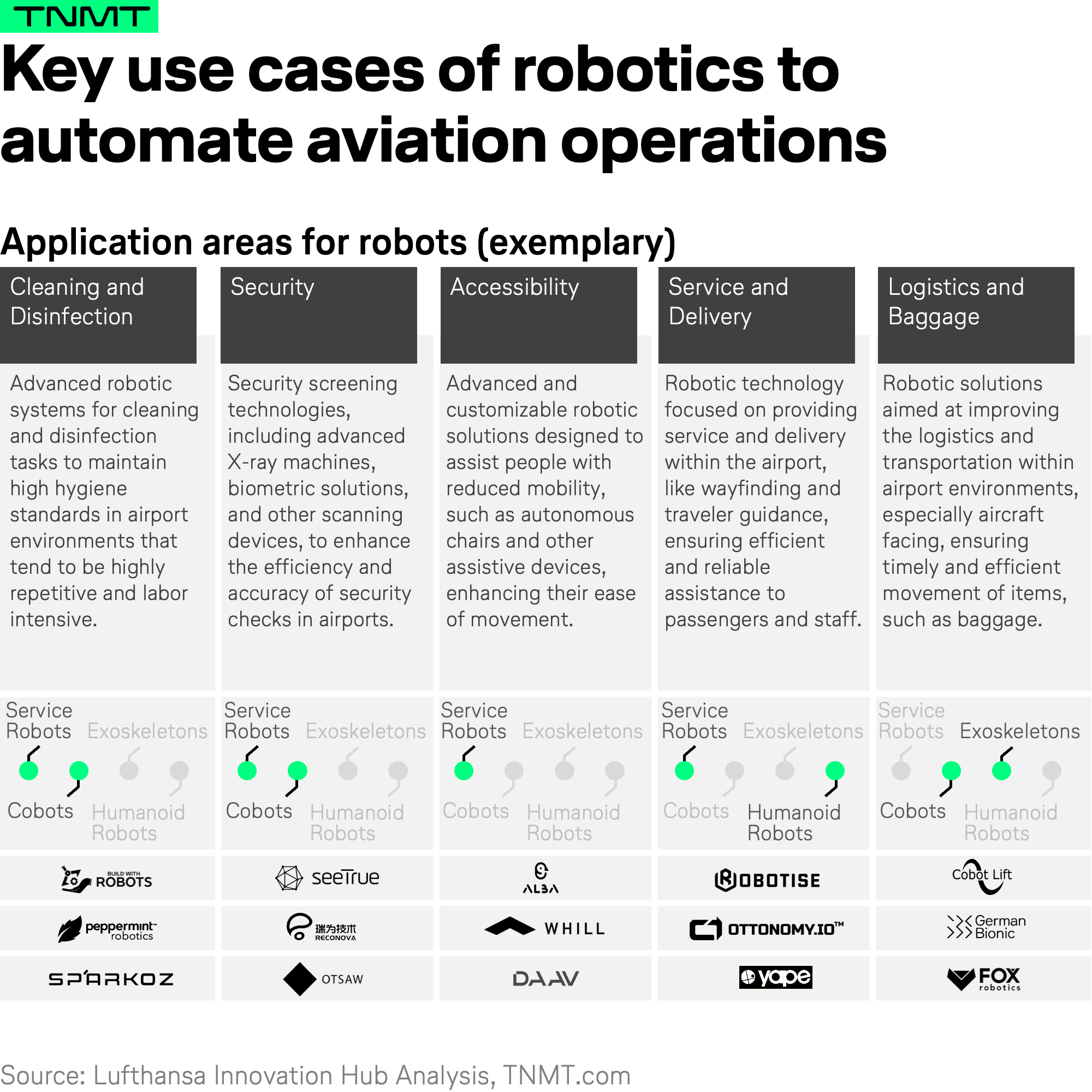
Airlines that lean into these areas, especially with active buy-in and co-creation mindsets, stand to gain more than smoother ops.
They’ll become active players in a reimagined traveler experience that delights customers and drives incremental revenue.
The era of “every player for themselves” in the airport ecosystem is over.
The next decade belongs to those who collaborate best.













